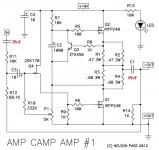Hi all
I plan to use my ACA's to power my mid-hf horn's, these are super efficient so the power of the ACA will be ample.
As these only need to run from 500hz up ( set by the hi pass filter on the horn crossover) would there be any real advantage of changing the values around the input to form a Hi pass filter say 400hz?
Thanks for your thoughts.
I plan to use my ACA's to power my mid-hf horn's, these are super efficient so the power of the ACA will be ample.
As these only need to run from 500hz up ( set by the hi pass filter on the horn crossover) would there be any real advantage of changing the values around the input to form a Hi pass filter say 400hz?
Thanks for your thoughts.
F=1/(2 x Pi x R x C)
so , counting on 10K for R , add input cap of 39nF
by same formula , calculate size of output cap ....... you don't need big honking electrolyte .....
so , counting on 10K for R , add input cap of 39nF
by same formula , calculate size of output cap ....... you don't need big honking electrolyte .....
Hello,
The French in the past did use 12 db filters at the input of the power amp and no filter at all between power amp and loudspeaker.
With horn loudspeakers you will have to use 12 db filter otherwise they will be damaged by receiving to much low frequencies. So in your situation just adding a cap, which is 6 db filter you will still need the filter between amp and loudspeaker.
Of course the amp will have an easier life if there are no low frequencies to amplify.
Greetings, Eduard
The French in the past did use 12 db filters at the input of the power amp and no filter at all between power amp and loudspeaker.
With horn loudspeakers you will have to use 12 db filter otherwise they will be damaged by receiving to much low frequencies. So in your situation just adding a cap, which is 6 db filter you will still need the filter between amp and loudspeaker.
Of course the amp will have an easier life if there are no low frequencies to amplify.
Greetings, Eduard
Yea, re read and yes I should have read it properly!
So for the output cap how would I calculate this, what is the R?
So for the output cap how would I calculate this, what is the R?
impedance of tweeter
practically , with one 6db/oct. cell on input and one 6db/oct. cell on output , you're ending with 12db/oct. filter
re-calculate values for your exact desired freq. and you're good
practically , with one 6db/oct. cell on input and one 6db/oct. cell on output , you're ending with 12db/oct. filter
re-calculate values for your exact desired freq. and you're good
So just the extra cap in series on the input give the 6db/Oct, i thought that a filter had a cap and a parallel resistor?
That's why I thought the cap would be in series with R11?
That's why I thought the cap would be in series with R11?
R11 is defining input impedance
Is it by purpose a relative small input impedance of 10k is chosen?
Would it be possible to raise to e.g. 47k?
I am using a passive preamp so would be good for me to have e.g. 47k instead of 10k. But 10k would also work I think.
So can we change the value of C3 to form this filter...
I have 2 of the new ACA kits on the way and the plan was to socket C3 so i could shrink its size to make a 1st order PLLXO to biamp the top of my WAW.

The less passive filter you can have, the better, i figure.
dave
The less passive filter you can have, the better, i figure.
dave
My thoughts exactly. I do like Zens idea to change the input and output caps to give a second order slope.
I did have a formula for working out the out cap value but can't find it. Tried the formula that Zen gave bit can't get his values, but them maths isn't my thing!
Might just trial and error it.
C=1/(2 x Pi x R x F) , [F],[Ohm],[Hz]
for input C , take desired F in Hz , and type 10K (input impedance ), for R
for output C , take desired F in Hz , and type impedance of driver, for R
for input C , take desired F in Hz , and type 10K (input impedance ), for R
for output C , take desired F in Hz , and type impedance of driver, for R
...and output caps to give a second order slope
In my case speaker is designed for 1st order filter and i don’t get the phase issues introduced by 2nd order filter.
dave
- Status
- Not open for further replies.
- Home
- Amplifiers
- Pass Labs
- Input filter on Amp Camp Amp
